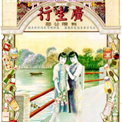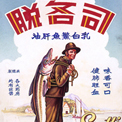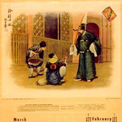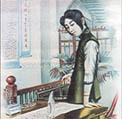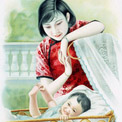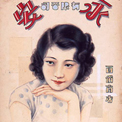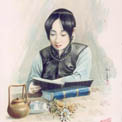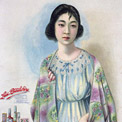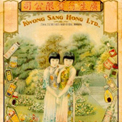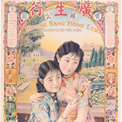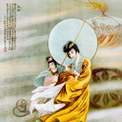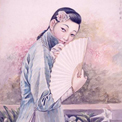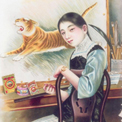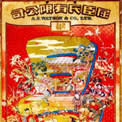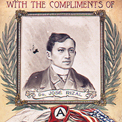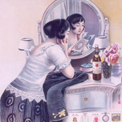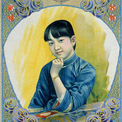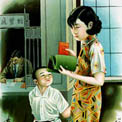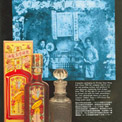Portrait of George Chinnery
Born in London in 1774, George Chinnery started to learn painting in London. He then moved to Dublin in 1796 and became a famous portrait painter. In 1802, he moved to India. During his twenty-three-year stay in India, he produced numerous portraits for local dignitaries and left numerous sketches and watercolour paintings portraying life in India. To escape from his creditors, he moved to Macau in 1825 and earned a living by painting. Chinnery created many masterpieces in Macau, including portraits of Guangzhou and British merchants, watercolour paintings and sketches depicting Guangzhou, Macau and the Pearl River. George Chinnery was named one of the best British painters living in East Asia in the 19th Century.
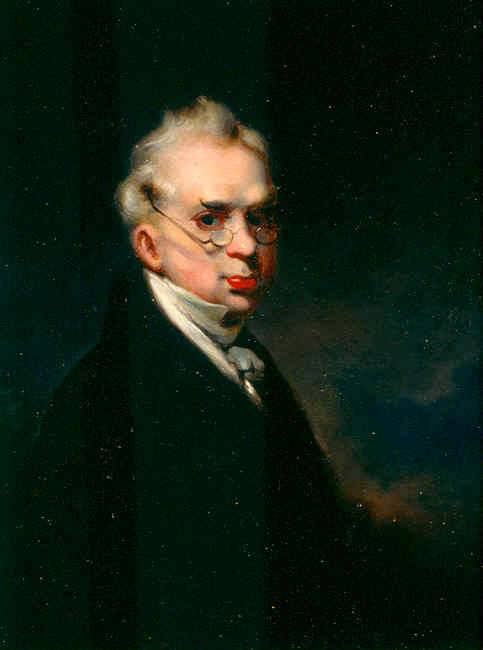
| Date | Around 1835 |
| people | George Chinnery |
| object | Chinese painting for export | historical painting | portraiture |
| Material Type | Image |
| Collection | Calendar posters of Kwan Wai-nung |
| Source | Hong Kong Museum of Art. Object No.: AH1991.0003, Caption: Portrait of George Chinnery |
| Note to Copyright | Permission for use is given by Hong Kong Museum of Art |
| Accession No. | KWL048 |
Portrait of George Chinnery
Born in London in 1774, George Chinnery started to learn painting in London. He then moved to Dublin in 1796 and became a famous portrait painter. In 1802, he moved to India. During his twenty-three-year stay in India, he produced numerous portraits for local dignitaries and left numerous sketches and watercolour paintings portraying life in India. To escape from his creditors, he moved to Macau in 1825 and earned a living by painting. Chinnery created many masterpieces in Macau, including portraits of Guangzhou and British merchants, watercolour paintings and sketches depicting Guangzhou, Macau and the Pearl River. George Chinnery was named one of the best British painters living in East Asia in the 19th Century.
| Date | Around 1835 |
| People | George Chinnery |
| Object | Chinese painting for export | historical painting | portraiture |
| Material Type | Image |
| Collection | Calendar posters of Kwan Wai-nung |
| Source | Hong Kong Museum of Art. Object No.: AH1991.0003, Caption: Portrait of George Chinnery |
| Note to Copyright | Permission for use is given by Hong Kong Museum of Art |
| Accession No. | KWL048 |
Portrait of George Chinnery
Born in London in 1774, George Chinnery started to learn painting in London. He then moved to Dublin in 1796 and became a famous portrait painter. In 1802, he moved to India. During his twenty-three-year stay in India, he produced numerous portraits for local dignitaries and left numerous sketches and watercolour paintings portraying life in India. To escape from his creditors, he moved to Macau in 1825 and earned a living by painting. Chinnery created many masterpieces in Macau, including portraits of Guangzhou and British merchants, watercolour paintings and sketches depicting Guangzhou, Macau and the Pearl River. George Chinnery was named one of the best British painters living in East Asia in the 19th Century.
| Date | Around 1835 |
| People | George Chinnery |
| Object | Chinese painting for export | historical painting | portraiture |
| Material Type | Image |
| Collection | Calendar posters of Kwan Wai-nung |
| Source | Hong Kong Museum of Art. Object No.: AH1991.0003, Caption: Portrait of George Chinnery |
| Note to Copyright | Permission for use is given by Hong Kong Museum of Art |
| Accession No. | KWL048 |
Portrait of George Chinnery
Born in London in 1774, George Chinnery started to learn painting in London. He then moved to Dublin in 1796 and became a famous portrait painter. In 1802, he moved to India. During his twenty-three-year stay in India, he produced numerous portraits for local dignitaries and left numerous sketches and watercolour paintings portraying life in India. To escape from his creditors, he moved to Macau in 1825 and earned a living by painting. Chinnery created many masterpieces in Macau, including portraits of Guangzhou and British merchants, watercolour paintings and sketches depicting Guangzhou, Macau and the Pearl River. George Chinnery was named one of the best British painters living in East Asia in the 19th Century.
| Date | Around 1835 |
| People | George Chinnery |
| Object | Chinese painting for export | historical painting | portraiture |
| Material Type | Image |
| Collection | Calendar posters of Kwan Wai-nung |
| Source | Hong Kong Museum of Art. Object No.: AH1991.0003, Caption: Portrait of George Chinnery |
| Note to Copyright | Permission for use is given by Hong Kong Museum of Art |
| Accession No. | KWL048 |
Portrait of George Chinnery
Born in London in 1774, George Chinnery started to learn painting in London. He then moved to Dublin in 1796 and became a famous portrait painter. In 1802, he moved to India. During his twenty-three-year stay in India, he produced numerous portraits for local dignitaries and left numerous sketches and watercolour paintings portraying life in India. To escape from his creditors, he moved to Macau in 1825 and earned a living by painting. Chinnery created many masterpieces in Macau, including portraits of Guangzhou and British merchants, watercolour paintings and sketches depicting Guangzhou, Macau and the Pearl River. George Chinnery was named one of the best British painters living in East Asia in the 19th Century.
| Date | Around 1835 |
| People | George Chinnery |
| Object | Chinese painting for export | historical painting | portraiture |
| Material Type | Image |
| Collection | Calendar posters of Kwan Wai-nung |
| Source | Hong Kong Museum of Art. Object No.: AH1991.0003, Caption: Portrait of George Chinnery |
| Note to Copyright | Permission for use is given by Hong Kong Museum of Art |
| Accession No. | KWL048 |
Portrait of George Chinnery
Born in London in 1774, George Chinnery started to learn painting in London. He then moved to Dublin in 1796 and became a famous portrait painter. In 1802, he moved to India. During his twenty-three-year stay in India, he produced numerous portraits for local dignitaries and left numerous sketches and watercolour paintings portraying life in India. To escape from his creditors, he moved to Macau in 1825 and earned a living by painting. Chinnery created many masterpieces in Macau, including portraits of Guangzhou and British merchants, watercolour paintings and sketches depicting Guangzhou, Macau and the Pearl River. George Chinnery was named one of the best British painters living in East Asia in the 19th Century.
| Date | Around 1835 |
| People | George Chinnery |
| Object | Chinese painting for export | historical painting | portraiture |
| Material Type | Image |
| Collection | Calendar posters of Kwan Wai-nung |
| Source | Hong Kong Museum of Art. Object No.: AH1991.0003, Caption: Portrait of George Chinnery |
| Note to Copyright | Permission for use is given by Hong Kong Museum of Art |
| Accession No. | KWL048 |
Portrait of George Chinnery
Born in London in 1774, George Chinnery started to learn painting in London. He then moved to Dublin in 1796 and became a famous portrait painter. In 1802, he moved to India. During his twenty-three-year stay in India, he produced numerous portraits for local dignitaries and left numerous sketches and watercolour paintings portraying life in India. To escape from his creditors, he moved to Macau in 1825 and earned a living by painting. Chinnery created many masterpieces in Macau, including portraits of Guangzhou and British merchants, watercolour paintings and sketches depicting Guangzhou, Macau and the Pearl River. George Chinnery was named one of the best British painters living in East Asia in the 19th Century.
| Date | Around 1835 |
| People | George Chinnery |
| Object | Chinese painting for export | historical painting | portraiture |
| Material Type | Image |
| Collection | Calendar posters of Kwan Wai-nung |
| Source | Hong Kong Museum of Art. Object No.: AH1991.0003, Caption: Portrait of George Chinnery |
| Note to Copyright | Permission for use is given by Hong Kong Museum of Art |
| Accession No. | KWL048 |
Portrait of George Chinnery
Born in London in 1774, George Chinnery started to learn painting in London. He then moved to Dublin in 1796 and became a famous portrait painter. In 1802, he moved to India. During his twenty-three-year stay in India, he produced numerous portraits for local dignitaries and left numerous sketches and watercolour paintings portraying life in India. To escape from his creditors, he moved to Macau in 1825 and earned a living by painting. Chinnery created many masterpieces in Macau, including portraits of Guangzhou and British merchants, watercolour paintings and sketches depicting Guangzhou, Macau and the Pearl River. George Chinnery was named one of the best British painters living in East Asia in the 19th Century.
| Date of Death | Around 1835 |
| People | George Chinnery |
| Object | Chinese painting for export | historical painting | portraiture |
| Material Type | Image |
| Collection | Calendar posters of Kwan Wai-nung |
| Source | Hong Kong Museum of Art. Object No.: AH1991.0003, Caption: Portrait of George Chinnery |
| Note to Copyright | Permission for use is given by Hong Kong Museum of Art |
| Accession No. | KWL048 |
Portrait of George Chinnery
Born in London in 1774, George Chinnery started to learn painting in London. He then moved to Dublin in 1796 and became a famous portrait painter. In 1802, he moved to India. During his twenty-three-year stay in India, he produced numerous portraits for local dignitaries and left numerous sketches and watercolour paintings portraying life in India. To escape from his creditors, he moved to Macau in 1825 and earned a living by painting. Chinnery created many masterpieces in Macau, including portraits of Guangzhou and British merchants, watercolour paintings and sketches depicting Guangzhou, Macau and the Pearl River. George Chinnery was named one of the best British painters living in East Asia in the 19th Century.
| Date | Around 1835 |
| Material Type | Image |
| Collection | Calendar posters of Kwan Wai-nung |
| Source | Hong Kong Museum of Art. Object No.: AH1991.0003, Caption: Portrait of George Chinnery |
| Note to Copyright | Permission for use is given by Hong Kong Museum of Art |
| Accession No. | KWL048 |
Portrait of George Chinnery
Born in London in 1774, George Chinnery started to learn painting in London. He then moved to Dublin in 1796 and became a famous portrait painter. In 1802, he moved to India. During his twenty-three-year stay in India, he produced numerous portraits for local dignitaries and left numerous sketches and watercolour paintings portraying life in India. To escape from his creditors, he moved to Macau in 1825 and earned a living by painting. Chinnery created many masterpieces in Macau, including portraits of Guangzhou and British merchants, watercolour paintings and sketches depicting Guangzhou, Macau and the Pearl River. George Chinnery was named one of the best British painters living in East Asia in the 19th Century.
| Date | Around 1835 |
| Material Type | Image |
| People | George Chinnery |
| Object | Chinese painting for export | historical painting | portraiture |
| Collection | Calendar posters of Kwan Wai-nung |
| Source | Hong Kong Museum of Art. Object No.: AH1991.0003, Caption: Portrait of George Chinnery |
| Note to Copyright | Permission for use is given by Hong Kong Museum of Art |
| Accession No. | KWL048 |
Portrait of George Chinnery
Born in London in 1774, George Chinnery started to learn painting in London. He then moved to Dublin in 1796 and became a famous portrait painter. In 1802, he moved to India. During his twenty-three-year stay in India, he produced numerous portraits for local dignitaries and left numerous sketches and watercolour paintings portraying life in India. To escape from his creditors, he moved to Macau in 1825 and earned a living by painting. Chinnery created many masterpieces in Macau, including portraits of Guangzhou and British merchants, watercolour paintings and sketches depicting Guangzhou, Macau and the Pearl River. George Chinnery was named one of the best British painters living in East Asia in the 19th Century.
| Date | Around 1835 |
| People | George Chinnery |
| Object | Chinese painting for export | historical painting | portraiture |
| Material Type | Image |
| Collection | Calendar posters of Kwan Wai-nung |
| Source | Hong Kong Museum of Art. Object No.: AH1991.0003, Caption: Portrait of George Chinnery |
| Note to Copyright | Permission for use is given by Hong Kong Museum of Art |
| Accession No. | KWL048 |
Portrait of George Chinnery
Born in London in 1774, George Chinnery started to learn painting in London. He then moved to Dublin in 1796 and became a famous portrait painter. In 1802, he moved to India. During his twenty-three-year stay in India, he produced numerous portraits for local dignitaries and left numerous sketches and watercolour paintings portraying life in India. To escape from his creditors, he moved to Macau in 1825 and earned a living by painting. Chinnery created many masterpieces in Macau, including portraits of Guangzhou and British merchants, watercolour paintings and sketches depicting Guangzhou, Macau and the Pearl River. George Chinnery was named one of the best British painters living in East Asia in the 19th Century.
| Date | Around 1835 |
| People | George Chinnery |
| Object | Chinese painting for export | historical painting | portraiture |
| Material Type | Image |
| Collection | Calendar posters of Kwan Wai-nung |
| Source | Hong Kong Museum of Art. Object No.: AH1991.0003, Caption: Portrait of George Chinnery |
| Note to Copyright | Permission for use is given by Hong Kong Museum of Art |
| Accession No. | KWL048 |
Portrait of George Chinnery
Born in London in 1774, George Chinnery started to learn painting in London. He then moved to Dublin in 1796 and became a famous portrait painter. In 1802, he moved to India. During his twenty-three-year stay in India, he produced numerous portraits for local dignitaries and left numerous sketches and watercolour paintings portraying life in India. To escape from his creditors, he moved to Macau in 1825 and earned a living by painting. Chinnery created many masterpieces in Macau, including portraits of Guangzhou and British merchants, watercolour paintings and sketches depicting Guangzhou, Macau and the Pearl River. George Chinnery was named one of the best British painters living in East Asia in the 19th Century.
| Date | Around 1835 |
| People | George Chinnery |
| Object | Chinese painting for export | historical painting | portraiture |
| Material Type | Image |
| Collection | Calendar posters of Kwan Wai-nung |
| Source | Hong Kong Museum of Art. Object No.: AH1991.0003, Caption: Portrait of George Chinnery |
| Note to Copyright | Permission for use is given by Hong Kong Museum of Art |
| Accession No. | KWL048 |
Portrait of George Chinnery
Born in London in 1774, George Chinnery started to learn painting in London. He then moved to Dublin in 1796 and became a famous portrait painter. In 1802, he moved to India. During his twenty-three-year stay in India, he produced numerous portraits for local dignitaries and left numerous sketches and watercolour paintings portraying life in India. To escape from his creditors, he moved to Macau in 1825 and earned a living by painting. Chinnery created many masterpieces in Macau, including portraits of Guangzhou and British merchants, watercolour paintings and sketches depicting Guangzhou, Macau and the Pearl River. George Chinnery was named one of the best British painters living in East Asia in the 19th Century.
| Date | Around 1835 |
| People | George Chinnery |
| Object | Chinese painting for export | historical painting | portraiture |
| Material Type | Image |
| Collection | Calendar posters of Kwan Wai-nung |
| Source | Hong Kong Museum of Art. Object No.: AH1991.0003, Caption: Portrait of George Chinnery |
| Note to Copyright | Permission for use is given by Hong Kong Museum of Art |
| Accession No. | KWL048 |
Portrait of George Chinnery
Born in London in 1774, George Chinnery started to learn painting in London. He then moved to Dublin in 1796 and became a famous portrait painter. In 1802, he moved to India. During his twenty-three-year stay in India, he produced numerous portraits for local dignitaries and left numerous sketches and watercolour paintings portraying life in India. To escape from his creditors, he moved to Macau in 1825 and earned a living by painting. Chinnery created many masterpieces in Macau, including portraits of Guangzhou and British merchants, watercolour paintings and sketches depicting Guangzhou, Macau and the Pearl River. George Chinnery was named one of the best British painters living in East Asia in the 19th Century.
| Date | Around 1835 |
| People | George Chinnery |
| Object | Chinese painting for export | historical painting | portraiture |
| Material Type | Image |
| Collection | Calendar posters of Kwan Wai-nung |
| Source | Hong Kong Museum of Art. Object No.: AH1991.0003, Caption: Portrait of George Chinnery |
| Note to Copyright | Permission for use is given by Hong Kong Museum of Art |
| Accession No. | KWL048 |
Portrait of George Chinnery
Born in London in 1774, George Chinnery started to learn painting in London. He then moved to Dublin in 1796 and became a famous portrait painter. In 1802, he moved to India. During his twenty-three-year stay in India, he produced numerous portraits for local dignitaries and left numerous sketches and watercolour paintings portraying life in India. To escape from his creditors, he moved to Macau in 1825 and earned a living by painting. Chinnery created many masterpieces in Macau, including portraits of Guangzhou and British merchants, watercolour paintings and sketches depicting Guangzhou, Macau and the Pearl River. George Chinnery was named one of the best British painters living in East Asia in the 19th Century.
| Date | Around 1835 |
| People | George Chinnery |
| Object | Chinese painting for export | historical painting | portraiture |
| Material Type | Image |
| Collection | Calendar posters of Kwan Wai-nung |
| Source | Hong Kong Museum of Art. Object No.: AH1991.0003, Caption: Portrait of George Chinnery |
| Note to Copyright | Permission for use is given by Hong Kong Museum of Art |
| Accession No. | KWL048 |
Portrait of George Chinnery
Born in London in 1774, George Chinnery started to learn painting in London. He then moved to Dublin in 1796 and became a famous portrait painter. In 1802, he moved to India. During his twenty-three-year stay in India, he produced numerous portraits for local dignitaries and left numerous sketches and watercolour paintings portraying life in India. To escape from his creditors, he moved to Macau in 1825 and earned a living by painting. Chinnery created many masterpieces in Macau, including portraits of Guangzhou and British merchants, watercolour paintings and sketches depicting Guangzhou, Macau and the Pearl River. George Chinnery was named one of the best British painters living in East Asia in the 19th Century.
| Date | Around 1835 |
| People | George Chinnery |
| Object | Chinese painting for export | historical painting | portraiture |
| Material Type | Image |
| Collection | Calendar posters of Kwan Wai-nung |
| Source | Hong Kong Museum of Art. Object No.: AH1991.0003, Caption: Portrait of George Chinnery |
| Note to Copyright | Permission for use is given by Hong Kong Museum of Art |
| Accession No. | KWL048 |
Portrait of George Chinnery
Born in London in 1774, George Chinnery started to learn painting in London. He then moved to Dublin in 1796 and became a famous portrait painter. In 1802, he moved to India. During his twenty-three-year stay in India, he produced numerous portraits for local dignitaries and left numerous sketches and watercolour paintings portraying life in India. To escape from his creditors, he moved to Macau in 1825 and earned a living by painting. Chinnery created many masterpieces in Macau, including portraits of Guangzhou and British merchants, watercolour paintings and sketches depicting Guangzhou, Macau and the Pearl River. George Chinnery was named one of the best British painters living in East Asia in the 19th Century.
| Date | Around 1835 |
| People | George Chinnery |
| Object | Chinese painting for export | historical painting | portraiture |
| Material Type | Image |
| Collection | Calendar posters of Kwan Wai-nung |
| Source | Hong Kong Museum of Art. Object No.: AH1991.0003, Caption: Portrait of George Chinnery |
| Note to Copyright | Permission for use is given by Hong Kong Museum of Art |
| Accession No. | KWL048 |
Copyright © 2012 Hong Kong Memory


